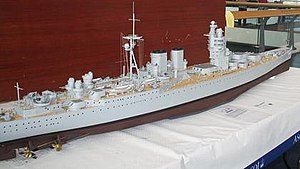 A 1:96 scale model of a G3 battlecruiser
| |
| Class overview | |
|---|---|
| Name | G3 |
| Operators | |
| Preceded by | Admiral class |
| Succeeded by | None |
| Planned | 4 |
| Completed | 0 |
| Cancelled | 4 |
| General characteristics (as of November 1921) | |
| Type | Battlecruiser |
| Displacement | |
| Length | 856 ft (260.9 m) |
| Beam | 106 ft (32.3 m) |
| Draught | 35 ft 8 in (10.9 m) (at deep load) |
| Installed power |
|
| Propulsion | 4 shafts; 4 geared steam turbines |
| Speed | 32 knots (59 km/h; 37 mph) |
| Range | 7,000 nautical miles (13,000 km; 8,100 mi) at 16 knots (30 km/h; 18 mph) |
| Complement | 1,716 |
| Armament |
|
| Armour | |
The G3 class was a class of battlecruisers planned by the Royal Navy after the end of World War I in response to naval expansion programmes by the United States and Japan. The four ships of this class would have been larger, faster and more heavily armed than any existing battleship (although several projected foreign ships would be larger). The G3s have been considered to be proper "fast battleships" since they were well-balanced designs with adequate protection. Nonetheless the class was officially designated as a "battlecruiser" due to their higher speed and lesser firepower and armour relative to the planned N3-class battleship design. The G3s would have carried nine 16-inch (406 mm) guns and were expected to achieve 32 knots (59 km/h; 37 mph), while the N3s would carry nine 18-inch (457 mm) guns on the same displacement at the expense of speed.[1]
The G3 design was approved by the Board of Admiralty on 12 August 1921. Orders were placed in October, but were suspended in mid-November shortly after the beginning of the Washington Naval Conference which limited battleship sizes. The orders were cancelled in February 1922 with the ratification of the Washington Naval Treaty which limited construction to ships of no more than 35,000 long tons (36,000 t) displacement.
- ^ Raven and Roberts, p. 90